-
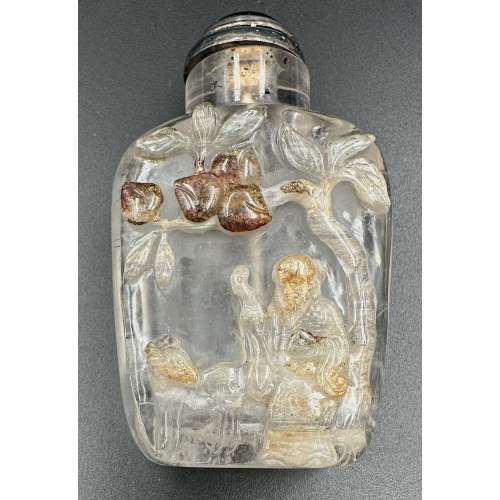 Snuff bottle made of rock crystal with brown skin carved with a sage and a deer under the peach tree on one side and a cuckoo on a plum tree on the other, with a chrysotile stopper and tin collar. Late 19th century. Dimensions: H68 x W40 x D21 mm.
Snuff bottle made of rock crystal with brown skin carved with a sage and a deer under the peach tree on one side and a cuckoo on a plum tree on the other, with a chrysotile stopper and tin collar. Late 19th century. Dimensions: H68 x W40 x D21 mm. -
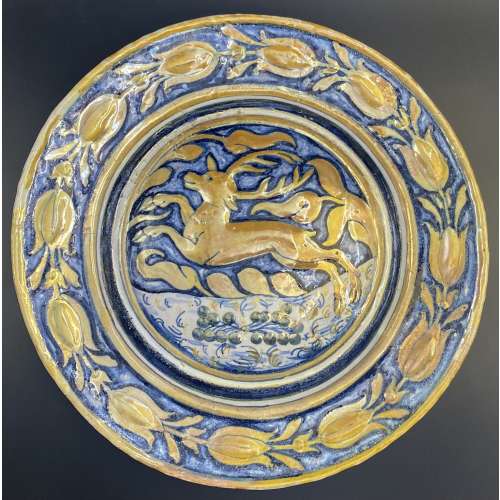 Tin-glazed earthenware plate with lustre in blue and ochre, decorated in relief with a deer in the centre and a chain of tulips on the lip; base signed “CK” in blue. Restored. Diameter: 24.8 cm; Height: 2.5 cm. Attributed to Gubbio (Umbria, Italy), 1520-1550.
Tin-glazed earthenware plate with lustre in blue and ochre, decorated in relief with a deer in the centre and a chain of tulips on the lip; base signed “CK” in blue. Restored. Diameter: 24.8 cm; Height: 2.5 cm. Attributed to Gubbio (Umbria, Italy), 1520-1550. -
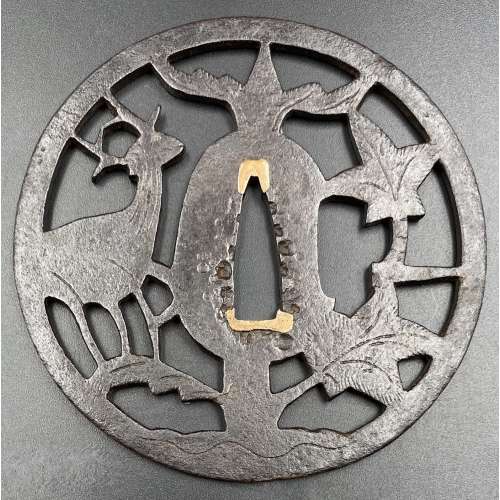
Iron tsuba of round form decorated with a deer and maple leaves in positive silhouette openwork (ji-sukashi), with details finely carved in low relief (kebori). Nakagō-ana plugged with copper fittings (sekigane). Traces of lacquer on the surface.
NBTHK: Hozon, №424947.
Design: An autumnal tsuba with an allusion to Kasuga Shrine in Nara.
Attributed by NBTHK to Shoami. Age: Probably the Momoyama period (1574 – 1603) or early Edo period (1603 – 1650), but judging on the item's substantial size (diameter 86.6 mm) and considerable thinness (3.4 mm) may be attributed to earlier times (late Muromachi period, 1514 – 1573). -
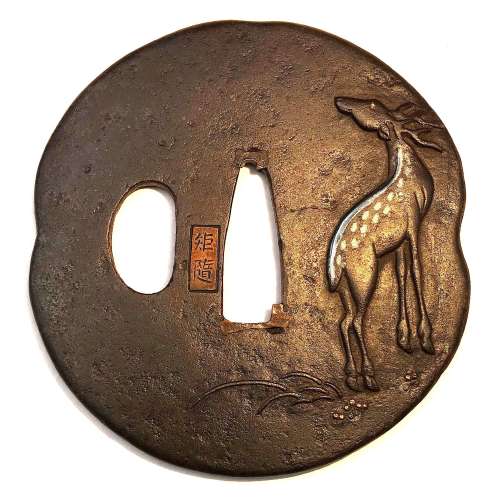 Iron tsuba of ryō-mokko-gata form decorated with a spotted deer (Nara deer or sika deer) motif in low relief carving (sukidashi-bori) and flat silver inlay (hara-zōgan); deer's eyes and details in gold inlay. Signed on a copper cartouche: Noriyuki. Grass in low relief carving on the reverse. There were two Noriyuki in Hamano school - father (Noriyuki I, 1736-1787) and son (Noriyuki II, 1771-1852). Frankly speaking, I don't know which one made this particular piece. Edo period, late 18th or early 19th century.
Iron tsuba of ryō-mokko-gata form decorated with a spotted deer (Nara deer or sika deer) motif in low relief carving (sukidashi-bori) and flat silver inlay (hara-zōgan); deer's eyes and details in gold inlay. Signed on a copper cartouche: Noriyuki. Grass in low relief carving on the reverse. There were two Noriyuki in Hamano school - father (Noriyuki I, 1736-1787) and son (Noriyuki II, 1771-1852). Frankly speaking, I don't know which one made this particular piece. Edo period, late 18th or early 19th century.Size: 71.5 x 70.0 x 3.0 mm.
-
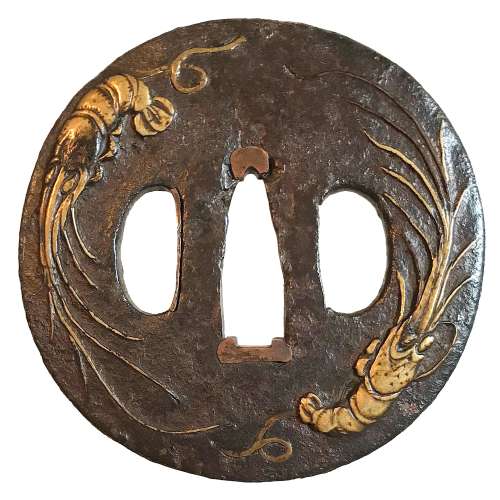 Iron tsuba of round form with two ebi (lobster) on omote (obverse side) and shika (deer) among scattered momiji (maple leaves) on ura (reverse side) motif in brass takabori (high relief) suemon-zōgan. Traces of lacquer. Unsigned. Late Muromachi / Momoyama period (late 16th / Early 17th century). Dimensions: 69.0.6 mm (H) x 69.6 mm (W) x 3.4 mm (T, seppa-dai). Weight: 92.6 g. Illustrated at: The Lundgren Collection of Japanese Swords, Sword Fittings and A Group of Miochin School Metalwork. Christie's Auction: Tuesday, 18 November 1997, London. Sales "GOTO-5881". Christie's, 1997. - #2 at page 7. Provenance: The second John Harding; The Lundgren Collection. Description at Christie's: "The iron plate depicting two lobsters in takabory and brass takazogan, the reverse similarly decorated with deer among scattered maple leaves, square mimi, late Muromachi / early Momoyama period (late 16th/early 17th century) Diameter 68 mm, mimi thickness 4 mm. Provenance: The second John Harding." Also at: JAPANESE SWORD-FITTINGS & METALWORK IN THE LUNDGREN COLLECTION. Published by Otsuka Kogeisha, Tokyo 1992. № 134. Description on page 173: Sword guard with design of shrimps in inlay (scarlet [sic] maple leaves and deer on the reverse side). Unsigned. Heianjō inlay school. Vertical 6.85 cm, horizontal 6.90 cm, Th. of rim 0.40 cm. Iron. Taka-bori relief and brass inlay. Momoyama period, 16th - 17th century. According to Merrily Baird, maple leaves, especially if paired with the deer, allude to autumnal tradition of Japanese aristocracy of viewing the seasonal changes of color in the Nara area. The lobster is typical Japanese ebi, - it lacks prominent claws, and has a spiny shell. As a symbol of longevity and good fortune, lobster is a staple of New Year's decoration.
Iron tsuba of round form with two ebi (lobster) on omote (obverse side) and shika (deer) among scattered momiji (maple leaves) on ura (reverse side) motif in brass takabori (high relief) suemon-zōgan. Traces of lacquer. Unsigned. Late Muromachi / Momoyama period (late 16th / Early 17th century). Dimensions: 69.0.6 mm (H) x 69.6 mm (W) x 3.4 mm (T, seppa-dai). Weight: 92.6 g. Illustrated at: The Lundgren Collection of Japanese Swords, Sword Fittings and A Group of Miochin School Metalwork. Christie's Auction: Tuesday, 18 November 1997, London. Sales "GOTO-5881". Christie's, 1997. - #2 at page 7. Provenance: The second John Harding; The Lundgren Collection. Description at Christie's: "The iron plate depicting two lobsters in takabory and brass takazogan, the reverse similarly decorated with deer among scattered maple leaves, square mimi, late Muromachi / early Momoyama period (late 16th/early 17th century) Diameter 68 mm, mimi thickness 4 mm. Provenance: The second John Harding." Also at: JAPANESE SWORD-FITTINGS & METALWORK IN THE LUNDGREN COLLECTION. Published by Otsuka Kogeisha, Tokyo 1992. № 134. Description on page 173: Sword guard with design of shrimps in inlay (scarlet [sic] maple leaves and deer on the reverse side). Unsigned. Heianjō inlay school. Vertical 6.85 cm, horizontal 6.90 cm, Th. of rim 0.40 cm. Iron. Taka-bori relief and brass inlay. Momoyama period, 16th - 17th century. According to Merrily Baird, maple leaves, especially if paired with the deer, allude to autumnal tradition of Japanese aristocracy of viewing the seasonal changes of color in the Nara area. The lobster is typical Japanese ebi, - it lacks prominent claws, and has a spiny shell. As a symbol of longevity and good fortune, lobster is a staple of New Year's decoration.


